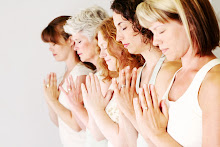Monday, August 25, 2008
Maricyasana III: Study Point of the Week
How can you get more deeply into your upper back? When we twist, we tend to keep the twist in the mid-back, around T-11, T-12, and L-1. Getting it into the upper back is a powerful way of increasing the twist and making it deeper.
Monday, August 18, 2008
Maricyasana III: Study Point of the Week
There are two ways to turn the head in this pose, looking behind you and looking toward your toes. Play with each one. Which do you prefer? Why?
Bhujangasana and the Core
(Laura) I have never spent much time studying Bhujangasana (Cobra Pose). I used it to warm up and strengthen my back and breezed past it whenever I was doing Sun Salutations. This month I studied it and taught it. In fact, I challenged myself to teach it each week in one class so I needed to come up with fresh information each week which necessitated new insights.
My most illuminating insight came from the importance of the core in Bhujangasana. I knew that extending the legs was important but I didn’t realize that I wasn’t using my inner thighs enough and, therefore, wasn’t engaging the core muscles in my torso. Without the core of my torso, my backbend sat in my lower back.
So? Practice this idea in Vajrasana or Sukhasana. Feel the length in your spine. Arch high up in the upper back. Now, from that position, let your belly go slack. Feel the back bend sink to your lower back.
The same thing happens in Bhujangasana (Cobra Pose) when you allow your legs to go slack (the legs support the work of the core muscles in the core – something you can feel in Tadasana (Mountain Pose)). When legs go slack, the backbend sits more in your lower back. The key to effectively activating the core is the inner thighs of the legs. Use those muscles to get the action into the torso as well.
My most illuminating insight came from the importance of the core in Bhujangasana. I knew that extending the legs was important but I didn’t realize that I wasn’t using my inner thighs enough and, therefore, wasn’t engaging the core muscles in my torso. Without the core of my torso, my backbend sat in my lower back.
So? Practice this idea in Vajrasana or Sukhasana. Feel the length in your spine. Arch high up in the upper back. Now, from that position, let your belly go slack. Feel the back bend sink to your lower back.
The same thing happens in Bhujangasana (Cobra Pose) when you allow your legs to go slack (the legs support the work of the core muscles in the core – something you can feel in Tadasana (Mountain Pose)). When legs go slack, the backbend sits more in your lower back. The key to effectively activating the core is the inner thighs of the legs. Use those muscles to get the action into the torso as well.
Subscribe to:
Comments (Atom)


